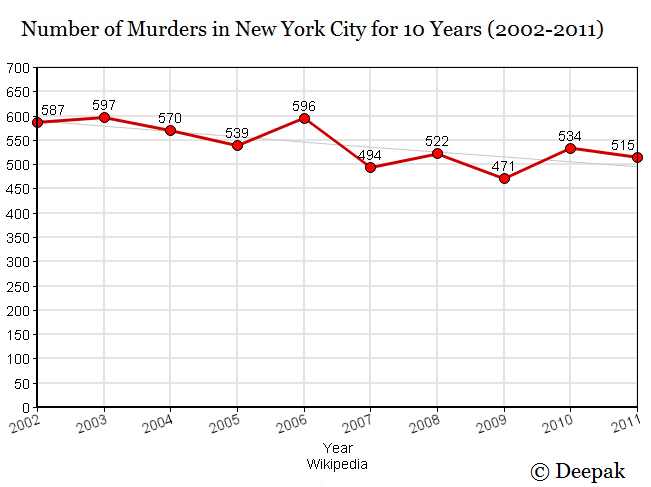What can the Crime Rate in New York teach us about Predictive Web Analytics?
In a world of logic, mathematics and numbers; predicting the future is a concept that may seem out of place and something that has to be left to the superstitious and emotionally driven group of the human kind. But even in a world of logic and precision, LLN (Law of large numbers) does a very good job of helping us predict the seemingly random events in the future and it has a very good reputation of being right most of the time.

To explain this, let me take the example of a particular crime in New York. I know what you are thinking – Crime in New York and Web Analytics? They are two different worlds! But I promise you that I will link the two with a common theory.
So what is common in New York and your website? Random events happen. Crime in New York is a random event with too many variables involved, but so are events on your web page such as subscriptions, clicks, downloads and sales. There is no website in the world where 100% of the visitors convert. How do we predict random events?
Magic happens when one deals with large numbers… and the magic is predictability and the “guarantee” of seemingly random events in the near future.
According to the law of large numbers – random events over a period of time and with large numbers always form a pattern.
“In probability theory, the law of large numbers (LLN) is a theorem that describes the result of performing the same experiment a large number of times. According to the law, the average of the results obtained from a large number of trials should be close to the expected value, and will tend to become closer as more trials are performed.” – Wikipedia
That pattern helps us predict random events, something as random as crimes in New York. Let us have a look at some facts. New York has a population of a little over 8 million. The number of times a particular crime was committed happened 542.5 times on average per year in the past 10 years ranging from 2002 to 2011.
That’s 0.000062% of the population in New York. Though there are too many variables involved in such a random event, there is a pattern because of the large sample size which helps us predict the future.

Predicting the Future
To a common mind, predicting something as random as the number of particular crimes committed in a particular city would seem like a crazy man’s goal. But a person (like you) exposed to the beauty of mathematics and analytics can predict the seemingly impossible future.
With the above data, one can say that the number of this particular crime in 2013 or 2014 would be around (+/-) 100 of 542.5 provided there are no major first page events such as an earth quake or highly contagious diseases spreading through the city. Even at the worst case, the number would not go below 300 or more than 700.
Predicting the Future of Web Events
We can apply the same concept to predict the events on a website like subscription, downloads, clicks, purchases and so on. Such events are random but can be measured and predicted which is one of the blessings of digital marketing.
Let’s say you have a landing page where you are giving away a free eBook on the topic of ‘How to Lose Weight Naturally in 30 days’. For users to download this ebook, they have to give away their name and email ID and subscribe to your mailing list.
If you drive 100 visitors to this page, chances are that may be 5% will opt in. The numbers may be different depending on the market, demographics and location. Let’s just take an example here.
For the next 100 visitors, the optin rate may be 7%. And for the next 100, it may be 3%. But over a period of time and thousands of visitors, the numbers will become more stable. For example, for every thousand visitors the numbers will become more predictable.
Let’s say that after driving 20,000 visitors to that landing page and you find out that the conversion ratio is 5.5%.
Now if you drive another 20,000 visitors to this page, it is highly likely that approximately 5.5% will optin as long as there is no major change in the landing page, demography, geography and psychography.
Using Predictability to Calculate Life Time Value of the Customer
Mathematics, analytics and predicting the future are nice surprises when working with web analytics but doesn’t actually help if we don’t use it in the right way. The best use of predictive analytics is in analyzing the life time value of the customer.
To understand the life time value of the customer, let us have a look at the sales/marketing funnel first.
The following is a good example of a funnel where the pricing stair case is made us of. Users are sent to a landing page with a freebie. Visitors become subscribers. Subscribers become customers who purchase once or more than once.

Here, the total revenue from the first level of purchases is only $2450. Most of the business owners will not go beyond this. If they have to spend $2450 in marketing budget to get those 10,000 visitors, they will not be ready to do it. But when future purchases are taken into account, the total revenue from the 10,000 visitors is more than double the initial revenue! With this in mind, spending $2,450 in buying that traffic makes sense.
Every visitor brings in revenue of $0.54 instead of $0.24 when the future purchases are taken into account.
For the sake of simplicity let us assume that there are no overheads other than the cost of buying traffic which means Revenue – Traffic cost = Profit. This translates to every visitor bringing in a revenue of $0.54. If the cost of buying the traffic is $0.30 per visitor, we can go ahead and buy 1,00,000 visitors for $30,000 without fear because we can be sure that our revenue would be $54,380 and profit would be $24,380.
As long as the traffic per visitor is less than $0.54, one can buy that traffic because though the purchases are random, it is predictable with large numbers.
To make room for anomalies, one can set a threshold of $0.45 CPV (cost per visitor) and can go out and buy the traffic with blind folded – knowing for sure that there will be profits in the future. This predictability is what makes mathematics interesting and online marketing VERY profitable for the ones who ‘get’ it.
So what do you think about large numbers, predictability and life time customer values? Are you already applying this in your business, if not, will you be using this in your business?